Bagni di Lucca has a long history of making figurines from Plaster of Paris, or gesso, as it is called here. The tradition began in the 13th century when people from Bagni di Lucca started going to France to sell their silk and they became intrigued by the use of Plaster of Paris to make mortuary masks.
They experimented with it, as the soft alabaster, one of the main ingredients to make that type of plaster, was abundant in the area. They realised it would be possible to make inexpensive religious statues by making moulds and filling them with plaster…much cheaper than the usual carved marble or stone.
The figurines became very popular, as not everybody could afford a Della Robbia, or other original for their home or church. Presepi, or nativity scenes were big sellers and salesmen from the area would travel far and wide selling their wares.
I was very lucky to be able to see one of the last producers of figurines in Bagni di Lucca, and the only one who still makes his statues by hand. Meet Simone from Arte Barsanti.
The business was started by Simone’s great-grandfather in 1900. At its peak there were 60 people employed. Now it is just Simone with some helpful advice from his uncle Carmelo.
The little factory is a treasure trove of figurines, moulds and paraphernalia from years of work.
Simone took us through the process of making a figurine. First the mould is prepared.
The plaster powder is mixed with water until it is the consistency of yoghurt.
Then is poured into the prepared mould and shaken to get out as many air bubbles as possible.
The statue is then left to cure for about 20 minutes. If the figurines are under 30cm high they are solid plaster. If they are bigger than that they are hollow to save on plaster and to make them less heavy.
Once out of the mould, the figurines are finished by hand to remove any rough patches and fill any small imperfections.
They are then fired in the wood fired oven room.
The next step is to hand paint each figurine. The flesh coloured parts are spray painted first.
The rest is painted with brushes of varying sizes.
We were taken to the top floor where there is a little museum with some of the history of the business.
There is a photo of a recent Pope receiving a Barsanti figurine.
…and some old presepi, including one in a pumpkin.
…some old accounting equipment.
Best of all was an old suitcase which the travelling salesmen would take around the country to display their wares.
There is a delightful story that when Christopher Columbus arrived in America the first person he saw was a fellow from Lucca with a suitcase full of presepi for him to choose from.
We were given a beautiful presepio to take with us…my first…thank you Simone and Carmelo for a wonderful visit.
I really hope this wonderful tradition can be kept alive in Bagni di Lucca.
info@artebarsanti.it
39 0583 87882
































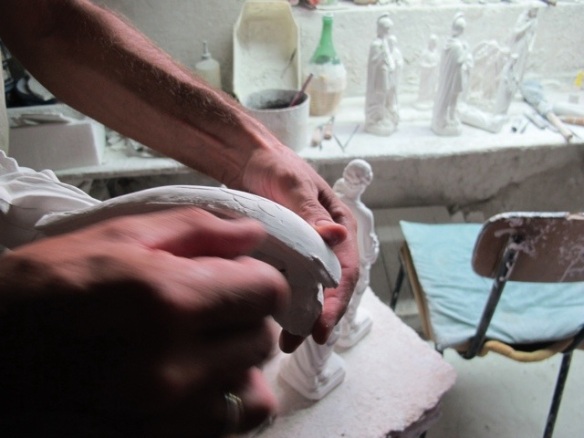

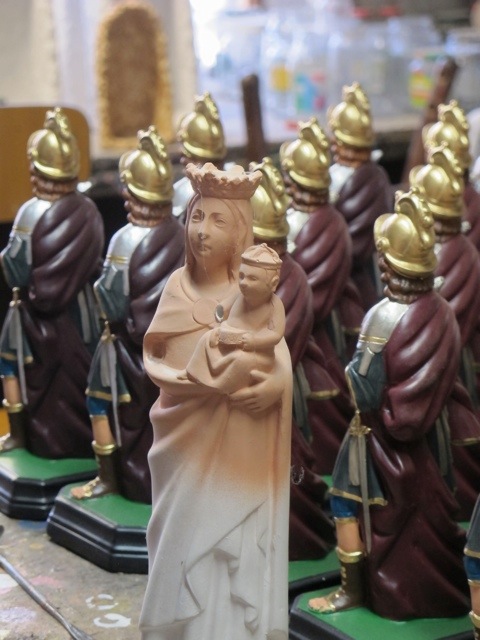



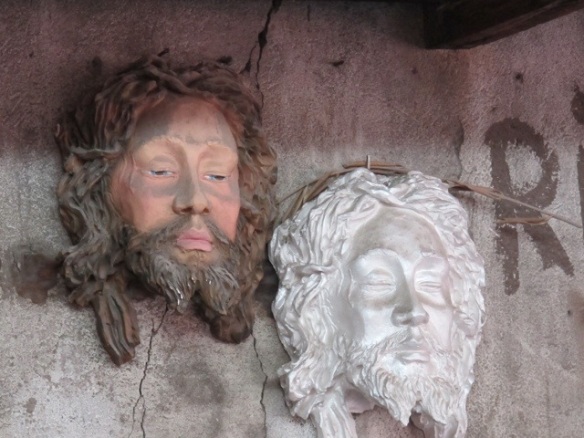
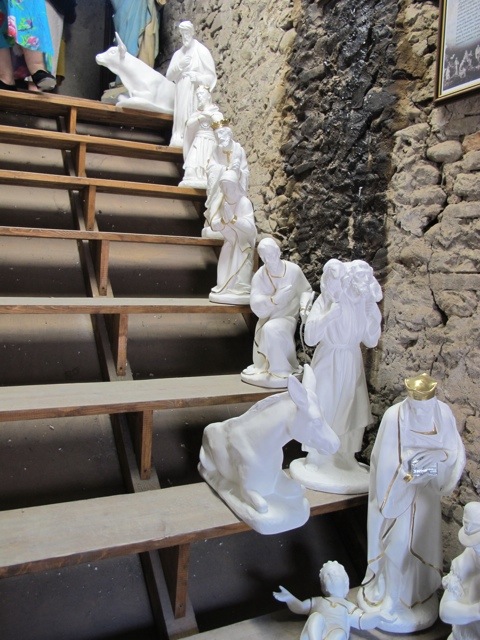

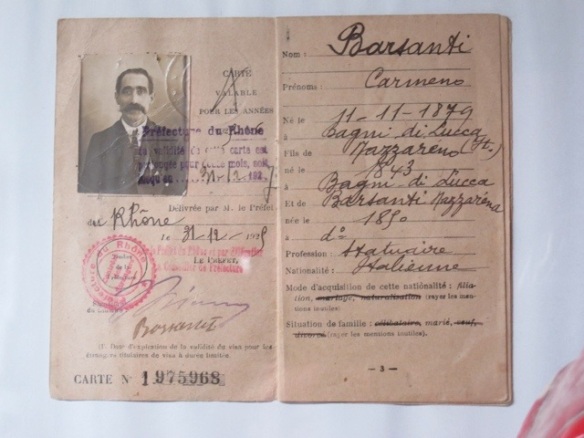
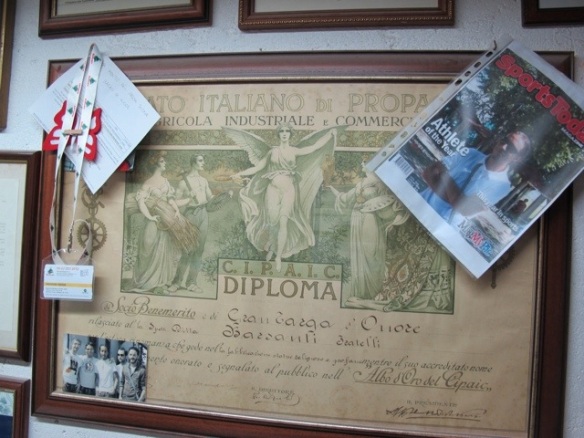

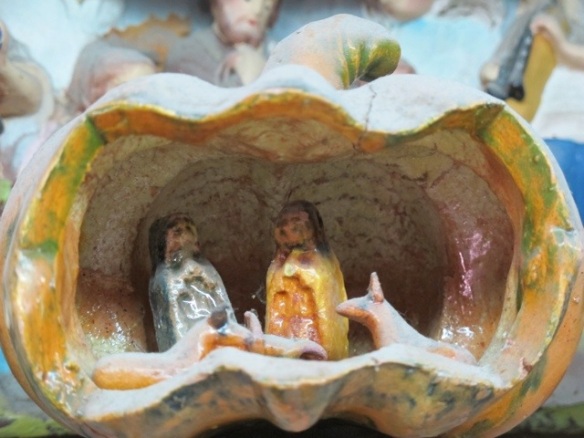
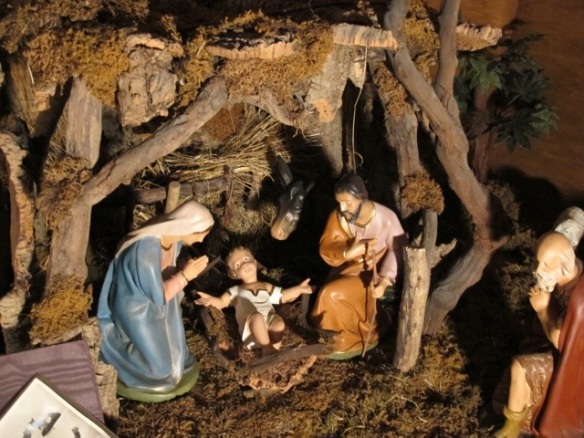
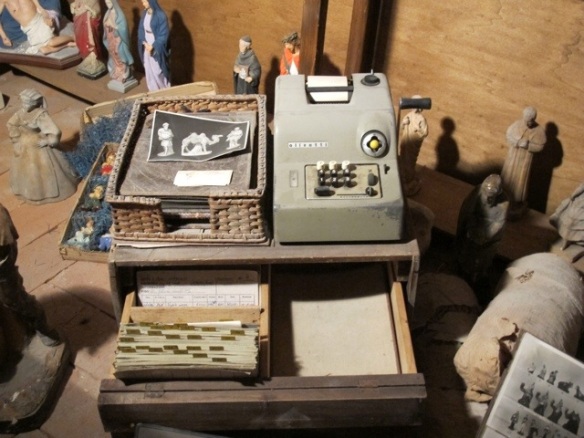
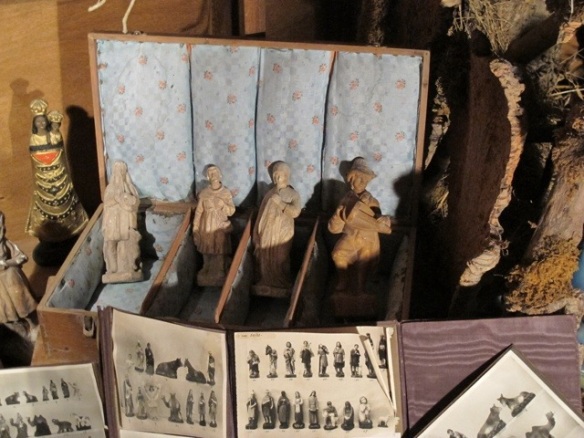
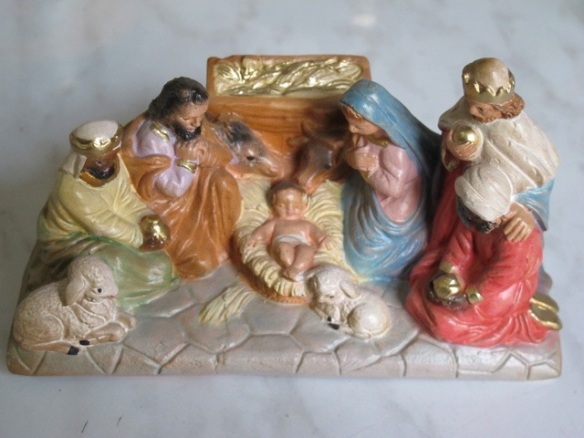
Fascinating post-really enjoyed this one
Thank you. I really enjoyed my visit to the factory.
Thanks for posting this Debra, I’m back in England now – but I’m coming back for a week on 24th July so I’ve made a note to see the exhibition 🙂 Hope you have a safe journey home
I wish I was here for the exhibition.
Great post Debra. It is about time someone mentioned the traditional crafts in Bagni di Lucca before these skills disappear completely. This is the sort of thing that will interest visitors to the area and increase business. It would be great to see a permanent display of figurines in the town and a point of sale. The public are tired of cheap reproductions “made in China” which can be bought in any market stall in any city. Something hand-made locally by craftsmen creates jobs and means so much more to the buyer.
I look forward to the exhibition and hope there will be many more.
A permanent exhibition would be an excellent idea. There are plenty of empty places available, and being able to buy them locally is essential.
I agree with you! Both of my grandfathers made and sold statues for a living here in the U.S. They along with many other family and friends, came here from the town of Crasciana, above Bagni Di Lucca. My father has always enjoyed making plaster statues as a hobby. I too think this art should continue and it would be great to see a shop that sold these figurines to tourists in Bagni Di Lucca.
I know Crasciana, it is a lovely little town with beautiful views of the mountains. I would love to see the figurines sold in Bagni di Lucca.
My aunt was Ada (nee Ricci) Nuti ,wife of Steve Nuti. She was from La Pieve di Monte di Villa.
Pieve di Monte di Villa is a beautiful village.
The figurines are very beautiful. Me too, I hope the keep this lovely tradition.
It would be wonderful to celebrate the industry and make it more visible.
There has been plans for a Museum of the Figurines in Bagni di Lucca; however, the lack of funds has been a major obstacle. I hope that this will change in the future…
A museum would be good, but this craft is still alive! It won’t be for very much longer if these skills are not encouraged and supported.
I agree with you Maureen, there should be a more public acknowledgment of this industry. Perhaps the mayor could make available a space in Bagni di Lucca ( there are lots of empty spaces ) for a permanent display and a possibility to buy.
Thank you Maria for organising the visit and providing all the great information.
A pleasure, Debra. just an extra comment on this topic, which is very dear to my heart. A modern museum does not need to be a mere celebration of the past or a lost craft. Most museums have nowedays a shop or boutique where goods are on display and old, so this would help the artisans. And yes, there are plenty of suitable buildings that could be used; however, it is not as simple as that. A building needs to be adapted to its new use and fitted accordingly (lights, furnishings, etc). A museum needs insurance, security and staff. Extra expenditure at a time when Council is short of funds and there are plenty of other needs in the area that cannot be disregarded.
The industry is suffering a lot, not only because of the current crisis, but also because of several other factors. Religious figurines, including nativity sets, are not as popular as they were in the past and they also face great competition from cheaper sources, which lack the quality of these pieces that, taking into account the enormous amount of work and skill required, are more than reasonable. We only have to look at the Arte Barsanti catalogue to realize that they are excellent value for money. When we think that the workshop used to employ 60 people and it is nowadays run by Simone on his own, it is easy to realize that conditions have changed dramatically. There used to be quite a few other crafts people working in small workshops only a few years ago; however, most of them have gone. And, more worrying… these skills used to be passed on amongst members of the family. Simone works on his own and has no apprentice. Let’s hope that a revival of traditional crafts will take place and all this artistic treasure is not lost.
Pingback: I wish I was in Bagni di Lucca right now | Bagni di Lucca and Beyond
Pingback: Two exhibitions at Circolo dei Forestieri | Bella Bagni di Lucca
Pingback: Lucchio | Bella Bagni di Lucca
Dear Debra, My father born in Riolo came to America when he was 14 years. He worked for
people from the same town who made the figurines. He then traveled around upper New York state selling the statues My father later founded founded his own business in Washington D.C.
which my brother and I still operate. However we are now in the business of ornamental plaster
such as fireplace mantels and crown moldings etc. We still use many of the same skills you so beautifully photographed and explained. Best wishes for the New Year.
Thank you for telling me about your connections to Bagni di Lucca. It seems its citizens went far and wide across the world, taking their skills with them. I am very pleased to hear that you have a successful business using those skills. Have you ever been to Bagni di Lucca?
Ciao Debra, Yes I have been to Bagni Di Lucca and to Riolo several times. I really like the photos of the villages. There is a great view of the several villages
from the road up to Benabbio . There is an organization called “Lucchesi nel
Mondo” located in Lucca at Mura Urbane 6. I am sure if you see Ilaria Del Bianco She will make you an hororary member as you have done so much
to showcase Bagni di Lucca for the rest of the world. Salve, Bob G
I hope we run into each other in Bagni di Lucca one day. I will definitely look for Ilaria when I go back to Italy next month. I have heard of Lucca nel Mondo. I know that road to Benabbio and, yes, there are some great views from there. I should stop and get some photos. Sent from my iPad
>
Pingback: About the blog | Bella Bagni di Lucca
Hi Debra. I’m a bit late replying through illness, but I have what I guess you could call a figurine, quite large, (I’ve always called it a statue) which was in my parents’ house for as long as I can remember – a wedding present perhaps. It is of a teenage boy with a little girl on his back. Recent research informed me that it was made by Camillo Triaca from a factory in Melbourne. He came to AUS from Lucignana, Tuscany, (what a gorgeous village) went back to Italy during the war, returned with a wife and owned “The Latin” a renowned restaurant in Melbourne. His son took it over but unfortunately it is no longer there. I cherish the statue and am very happy that a niece would like it when I fall off the perch!
How lovely! Thank you for telling me. There is a Lucignana very close to Bagni di Lucca. I have passed the signpost to the village often. I guess it is the same one. I will go there when I return and take some photos. It is amazing how many people have a connection with these tiny villages.
I hope you are feeling better now.
Pingback: Italy Magazine Blog Awards | Bagni di Lucca and Beyond
I am lucky enough to have a few figurines from a nativity scene. They were given to me when we lived in Bagni di Lucca in the early 50s before we came to Australia. Dina
Lucky you. I wish that some of these could be on permanent display in Bagni di Lucca.
Not sure how I missed this wonderful post when it first came around. This is a topic near and dear to my heart. So many businesses here in the US originated from the figurine industry in Bagni di Lucca. My family’s business was among them. Several generations later, we still owe a great debt to the hard workers who came to the US and worked in this industry. My father, a native of Pieve di Monti di Villa, came to Philadelphia after the war, worked for Bagni di Lucchesi who had arrived years before and had started their own statuary business. Through very hard work and much sacrifice, my father was able to build his own business and employ many other Bagni di Lucchesi. From carnival type figurines the business evolved to the manufacture of beautiful table lamps and other lighting that were sold nationwide.
I love this story! Bagni di Lucca has sent many people out into the world with their skills…it is wonderful.
Pingback: The Italy Magazine Blog Awards | Bella Bagni di Lucca
And again….A big thank you to all the English speaking people who loves the Bagni di Lucca area.
We bought our apartment in 2003 and we really love the time we spend in Bagni di Lucca.
Pingback: A win for Bagni di Lucca | Bella Bagni di Lucca
Pingback: On a happier note | Bagni di Lucca and Beyond
Debra,
Wow I just read your article and it really hit’s home. I guess I’m a child of Bagni Di Lucca craftsmen. Both Grandfathers were figurine makers from the area and carried their craft to the US. My parents met in BDL at Bar Italia (circa 1954), mom working behind the bar and dad there on vacation with Nonna and Nonno. My dad’s family are from Beautiful Riolo, while mom’s family lived on the road up to Riolo.
I’ve tried to introduce my kids to the art of making statues, but, they’ll have none of it. I guess it’s just another art that will die when this generation.
Hopefully my wife and I will be in Tuscany soon, we plan on spending a month there after I retire in a couple years.
ciao
Chris
You must be related to Mike Prosperi. He visits Riolo regularly. It is quite amazing the number of people who are descended from Bagni di Lucca artisans. I would love to see a permanent museum set up in the town to honour this tradition. Perhaps the descendants need to get together to organise it.
I did a post on Riolo recently.
Mike is my cousin, but, he’s like a brother to me. He lived next door growing up and we talk on a regular basis, I actually have a few pictures of his home in RIolo on my website. (Prosperi-rentals.com).
I did hear Debra that the Figurine trade is much older in this region than that and that there was evidence of Artisans back in Roman times making figurines of ‘Gods’ to act as sacrificial tokens or to embellish Shrines, especially in the areas around Vico Pancelorum and Palleggio.
That seems quite likely. I wonder if any of these have been discovered.
Pingback: Making figurines | Bella Bagni di Lucca
Hi- have really enjoyed this blog. I am especially interested in this section on the plaster figure maker. My great great great grandfather Giovanni Bianchi was a figure maker who came to London about 1825. He made plaster busts and figures as well as death heads of criminals. He set up his business in Norwich, possibly taking over from Pellegrino Mazzotti. He died in Norwich in 1872 aged about 65. I believe he was born in the Serchio valley but have not yet located his place of birth. We have been to the museum in Coreglia but will have to visit Bagni next time. Hope I can find my ancestor’s roots. Best wishes.
Plaster makers from Bagni di Lucca took their skills all over the world. I hope you do come and find records of your ancestors. Unfortunately there are many villages in the area, making it difficult to track down records. I would suggest doing some research before you come and get as many details as possible. Good luck.
Hello,
My maternal grandmother was born 1881 in Bagni di Lucca. Her father had a shop in Munich, Germany, where he made figurines and sold them there. The family‘s name was Quilici.
Crisostomo Quilici, my great-grandfather was born in 1852 in Ponte Mariano and died 1912 in Munich.
My grandmother Giuseppina Quilici met my grandfather Filippo Martini from Taggia, Imperia, in Munich. My mother and her three younger siblings were all born in Augsburg, Germany, between 1908 and 1914. They were all in the flower business from Sanremo, Imperia. Only my granduncle, Primero Silvestro Quilici, had taken over the figurine business in Munich. He died 1931 in Munich and with him the business as his son was not working in it.
I was in Bagni di Lucca many years ago to see the birthplace of my grandmother, and I wanted to check with the municipal administration about some family data. But unfortunately, it was closed in the afternoon and I could not stay overnight. I got some information by letter correspondence.
„By accident“ I came over your interesting blog and now made up my mind to visit BDL again, this year, and stay for 3-4 days. Maybe I find some more information about the Quilici family, maybe the name of a brother or sister of my greatgrandfather. I have a picture of before 1900 on which father Crisostomo and son Primero are working on a beautiful figurine in man size.
I enjoyed very much reading all the postings! Thanks a lot….
Thank you for telling your story. I love to hear these connections. There is a Ponte a Moriano between Lucca and Bagni di Lucca. I wonder if this is where your family is from. I hope you have a successful visit to Bagni di Lucca.
A fascinating website. Thank you for creating it. I’m assisting a lifelong friend in discovering her Italian roots. Her family was from Bagni di Lucca. They were figurine makers (all this discovered recently).
They emigrated circa 1890 arriving in New York City where many of them remained. Some, however, left NYC for Perth Amboy, NJ, to become terra cotta mold makers. Perth Amboy had been famous for its terra cotta.
It’s interesting as so many of my friend’s family were extremely artistic.
She is too.
We’re trying to ascertain where a Florindo Lena (her great grandfather) is buried. He died prior, we believe, to 1890 or so. Also trying to find where her grandfather, Lorenzo Manzoli, is buried. Lorenzo was a figurine maker but we are unclear if he originated in Bagni di Lucca.
The Lena family was filled with the figurine makers.
Any help or advice would be so much appreciated as she is working on this project to impart the information to her sons, grandchildren, and nieces and nephews.
Thank you.
You could try connecting with Ann Barsi. There are a few posts on the blog about her work.
Pieve di Monte di Villa records
A new edition of Pieve di Controne
Family
Pieve di Controne.
Type the names in the “search” box.
Ann has written books about families in Bagni di Lucca.
The library in La Villa has records of families in the area if you ever visit.